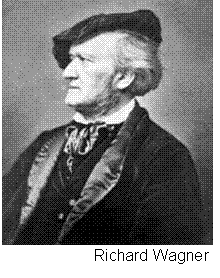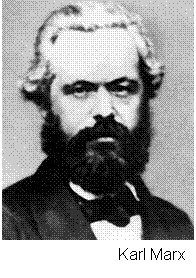Essay (back
to top)
“My dear Wilhelm …if you think that you can harm even one Jew with this weapon of yours, you’ve lost your marbles.”
-Julius Stettenheim, editor of the journal Wespen.
(Zimmermann, 51)
Wilhelm Marr’s biography by Moshe Zimmermann provides an insightful and comprehensive analysis of events that cause Marr to become the “Patriarch of Anti-Semitism.” Anti-Semitism is by definition hostility or prejudice against Jews as a religious, ethnic, or racial group. It can range from expression of individual hatred to institutionalized, violent persecution (Wikipedia, Anti-Semitism). Wilhelm Marr was a German agitator and theorist who coined the term “anti-Semitism” as a euphemism for the German Judenhass or Jew-hate (Wikipedia, Wilhelm Marr). Zimmermann’s exceptional work provides detailed accounts of events that Marr experienced, which led him to formulate anti-Semitic beliefs.
Nineteenth Century Germany: A Time of Rapid Change
The nineteenth century in Germany can accurately be described as a time of political and social turmoil. A century filled with political upheaval and social unrest. Zimmermann describes Germany as a society caught between modernization and reaction (Zimmermann, 115). The pinnacle of social discontent in Germany unfolded during the 1848 revolution. New political institutions emerged during this period of reformation in Germany. Radicals, or Jacobins as they were called, began gathering in cities across Germany, cities which harbored and supported radical change.
Germany, a country which struggled throughout the 1800’s to unify its various territories, gave rise to a new nationalist movement within its population. The nationalist movement concluded with the apex of social discontent in 1848. This year was highlighted by a revolution that pitted social liberals against traditional rule in the German states. Zimmermann describes this year as an explosion of radical beliefs. “In 1848 the shell exploded in Germany: revolutions erupted or constitutional changes were implemented to allay fears of revolution in all the German states” (Zimmermann, 5). Clearly the stage in Germany was primed to foster radicals, and as demonstrated by Zimmermann, Germany was undergoing a drastic overhaul of its political system fueled by the people, particularly the bourgeoisie class.
Zimmermann begins his analysis of Wilhelm Marr, a revolutionary democrat, through his family origins. Marr was born on November 16, 1819 to Heinrich Marr and Katharina Henriette Becherer. His father Heinrich was a very popular actor throughout Germany, which forced Marr to change schools frequently as a young adult (Zimmermann, 9). Marr’s grandfather, Johann Wilhelm, is also discussed in great detail, because of his influence on Marr. He and his grandfather spent many years together. Interestingly, Wilhelm Marr never denied that his grandfather was Jewish, a religion that Marr later grew to despise. Marr’s father and grandfather played a critical role in shaping Marr’s mind during childhood.
Over the course of his life, Marr married several Jewish women. Three areas of Marr’s life influenced him to develop hatred towards the Jewish populace. Marr’s hatred for the Jews stemmed from personal rivalries and disappointments. He could no longer prevail in Hamburg or earn a decent living as a journalist in what came to deride as the “Jewish Press” (Niewyk, 587). I will first examine Marr’s unhappiness in these relationships below. Secondly I will address the international situation that faced Germany during the nineteenth century, which permitted Marr to rise to power in Hamburg and use the press to spread his beliefs about the Jewish populace in Germany. Finally, I will investigate the radical ideas that led Marr to coin the term “anti-Semitism”. Zimmermann clearly illuminates these three areas of Wilhelm Marr’s life.
Jewish Women and Wilhelm Marr
In 1873 Marr divorced his first wife, Johanna Bertha, after more than two decades of marriage, so that he could marry another woman. On February 26, 1874, fifty year old Wilhelm Marr married a thirty-eight year old woman, Helene Behrend, a pure-blooded Jewess [Volljudin] whose mother’s maiden name had been Israel (Zimmermann, 70). This is the origin of Marr’s frustration with Jewish people. Marr described in his memoirs that his marriage with Behrend was filled with unhappiness, and was indicative of his future relationships with women. This marriage was indicative of Marr’s future relationships with women. This was the birth of a snowball effect that eventually led Marr down a path of hatred.
Marr married two more times, both culminating in bitter divorces. The last woman he married, Jenni Kornick, a well known writer in Hamburg. However, this marriage did not last long. “From the beginning, Marr’s life with his new wife was extremely difficult. He separated from her less than a year later and divorced her in 1877, two years after their marriage” (Zimmermann, 72). It is evident that Marr was unable to maintain a relationship with a Jewish woman for long, and the one time he did with his first wife, Marr regretted marrying her. He described in his memoirs “I at least came to know the Semitic race in a thorough manner, in its most intimate details, and I warn against the mingling of Aryan and Semitic blood” (Zimmermann, 72). His last marriage was a costly one, because his son Heinrich had been born. Consequently, Marr was obligated to support his ex-wife. He cursed himself for this mistake, which burdened him financially (Zimmermann, 72).
This display of uncanny behavior with Jewish women prompted Marr to look for a satisfactory relationship elsewhere. His growing dislike for Jews was influenced by his personal experience with three failed marriages. Undoubtedly these marriages took an emotional toll on Marr, one that he had to be dealt with throughout the German revolution of 1848, and his political career in Hamburg. Jewish women left Marr with a bitter feeling towards the rest of the Jewish populace, because he had miserable experiences with his Jewish wives.
Marr’s Political Power: The Hamburg Days
Throughout these turbulent times for Marr, his failed marriages were not the only experience that led him to form anti-Jewish beliefs. International and political events influenced him as well. Marr’s radicalism and republicanism laid at the base of his negative image of Jews. He declared in the radical Hamburg Constituent Assembly that, “German unity had become Germany’s disgrace” (Zimmermann, 27). Marr argued that “the Jews are a state within a state and preserve their nationality by means of ghetto, by means of religion alone, but nevertheless want to have equal rights in a non-Jewish state. His solution to this was total assimilation, which would bring about real emancipation” (Zimmermann, 47). Despite his conservative views Marr was an intelligent politician, initially refusing to take an anti-Semitic stance during his campaign to gain a seat in Hamburg’s parliament. Although a significant portion of Hamburg’s population during the 1800’s was Jewish. Marr was able to win a seat in the parliament [Burgerschaft] in 1861 (Zimmermann, 37). This was the political power that Marr needed to disseminate his opinions on Jews through his use of the press.
Marr’s life experiences gave him reason to dislike the Jewish population. However, he still needed to get his foot in the political door. Once Marr was allowed to participate in the Hamburg government, he was able to unveil his ideas about flaws within Jewish communities, and how they were a burden to Germany on its quest for greatness. Marr published his first anti-Semitic book, titled DerJudenspiegel which in translation this means the “Jewish mirror.” This was Marr’s greatest attack on the Jewish people. In 1879, Marr wrote another anti-Semitic book, The Victory of Judaism Over Germanism. Marr used publications as a method to reach as many non-Jews readers as possible. At this point in Marr’s political career his fame began to diminish rapidly. His anti-Semitic stance met strong opposition from the Jewish population of Hamburg.
Influential Figures in Marr’s Life
 In addition to Marr’s political power, which enabled him to spread the sinister ideals of anti-Semitism, he was influenced by other Germans. Marr’s contemporary Richard Wagner was one of those influences. Wagner was an influential German composer, music theorist, conductor, and essayist. Wagner frequently accused the Jews, specifically Jewish musicians, of being harmful aliens of German culture (Wikipedia, Richard Wagner). Although Wagner later called Marr “superficial” for recanting his anti-Semitic views, Wagner motivated Marr to spread the word on Germany’s problem with the Jews. According to Marr, this problem arose when the Jewish people were reluctant to participate in the revolution of 1848. The great luminaries, in whose shadow Marr’s soul and thoughts wandered during those years, were Karl Marx, Ferdinand Lassalle, Richard Wagner, and Johannes Scherr (Zimmermann, 73). These historical figures were already addressing the issues of Germany with radical ideas that attacked the current system of government in a fundamental way. In addition to Marr’s political power, which enabled him to spread the sinister ideals of anti-Semitism, he was influenced by other Germans. Marr’s contemporary Richard Wagner was one of those influences. Wagner was an influential German composer, music theorist, conductor, and essayist. Wagner frequently accused the Jews, specifically Jewish musicians, of being harmful aliens of German culture (Wikipedia, Richard Wagner). Although Wagner later called Marr “superficial” for recanting his anti-Semitic views, Wagner motivated Marr to spread the word on Germany’s problem with the Jews. According to Marr, this problem arose when the Jewish people were reluctant to participate in the revolution of 1848. The great luminaries, in whose shadow Marr’s soul and thoughts wandered during those years, were Karl Marx, Ferdinand Lassalle, Richard Wagner, and Johannes Scherr (Zimmermann, 73). These historical figures were already addressing the issues of Germany with radical ideas that attacked the current system of government in a fundamental way. 
Karl Marx, a Jewish critic of the economic system that was implemented in Germany also played a pivotal role in Marr’s eventual views on Jews. Because Marr lived through Germany’s Industrial Revolution he began to study the work of Marx regarding capitalism and the working class. Marx’s book Das Kapital appeared in a second edition in Hamburg where Marr caught his first glimpse of Marxist ideals. Surprisingly, even through Marx was communist, Marr refused to accept Marx as a communist since he believed the force moving the world was individualism (Zimmermann, 73). As a young adult, Marr became interested by the writings of Niccolo Machiavelli a political philosopher, musician, and poet of the Italian Renaissance (Wikipedia, Niccolo Machiavelli). He began to study the writings of Machiavelli. “He centered his attention on the Discorsi, since the concept of “people” or Volk interested him the most. Marr later admitted that  from the work of Machiavelli he learned to regard people not as a collection of individuals, but as a universe with its own pace and natural laws (Zimmermann, 25). It is evident that these people had a role in shaping and guiding Marr’s beliefs. In addition, Germany in the nineteenth century was a hotbed of radical ideals. from the work of Machiavelli he learned to regard people not as a collection of individuals, but as a universe with its own pace and natural laws (Zimmermann, 25). It is evident that these people had a role in shaping and guiding Marr’s beliefs. In addition, Germany in the nineteenth century was a hotbed of radical ideals.
Conclusion (back to top)
Wilhelm Marr was influenced by this radical intellectual environment in his eventual stance against the Jewish people. This was fueled by multiple failed marriages with Jewish women who caused him personal anguish. The next aspect that aided Marr, the patriarch of anti-Semitism, was his use of the press. With the publication of two major attacks on the Jewish people, Marr began to create enemies all over Hamburg, which had a significant Jewish population. The final factor that led Marr to his anti-Semitic views was the influential radical people who resided in Germany during the nineteenth century. These people and their writings helped to convince Wilhelm Marr to view the world through radical eyes.
Interestingly, Wilhelm Marr later recanted his anti-Semitic views. Marr, the man who introduced the term anti-Semitism into politics, turned his back on anti-Semitism and became the sharpest critic of that movement (Zimmermann, 115). Marr broke with the anti-Semites, rebuking them bitterly for betraying their own ideals by commercializing the movement. He called its depraved manifestation “commercial anti-Semitism” (Geschaftsantisemitismus), and concluded paradoxically that organized anti-Semitism had itself become “Jewish” (Meyer, 442).
Marr was outcast by 1889, and his colleagues within the anti-Semitic League demoted him to seventh place on the list of founders of the anti-Semitic movement (Zimmermann, 114). Zimmermann calls the concept itself inappropriate “since there are other peoples with a Semitic language who are opposed to the Jews.” It was preferable, in the opinion of the Handbook’s editor, an anti-Semitic journal to use the term “adversary of the Jews” (Judengegner) (Zimmermann, 114). “The term anti-Semitism, which was coined by a descendent of the Jews, Wilhelm Marr in 1879, is unsuitable, if only for the reason that there are other peoples with Semitic languages, such as the Arabs, who stand in complete opposition to the Jews” (Zimmermann, 115). It was clear that the term anti-Semitism was not used to discriminate racially, but spiritually.
Wilhelm Marr died on July 17, 1904. Few noticed when Marr died in poverty in 1904, and the Nazis, when they recalled him at all, were to label him as half-Jew and repudiate his word Antisemitismus as misleading and imprecise (Niewyk, 588). His legacy of transforming modern anti-Semitism, however, was already firmly imprinted on future German generations. Richard Wagner and others such as the members of the anti-Semitic league denounced Marr 1889. Marr ended up alone and died a quiet death. He did influence the movement that later gave rise to the Third Reich. Marr left behind a set of beliefs that was used to terrorize German Jews in the twentieth century following the rise of Adolf Hitler. Millions of Jews were eventually murdered in gas chambers or shot in mass executions, partially because the views initially spread by Wilhelm Marr, accusing the Jewish populace of perpetuating Germany’s longstanding problem of political turmoil, social upheaval, and economic strife. Anti-Semitism was Marr’s answer for ‘Germany’s solution to the Jewish problem.’
“Anyone who can not hold his own has to go.” -Wilhelm Marr (Zimmermann, 67)
|

 In addition to Marr’s political power, which enabled him to spread the sinister ideals of anti-Semitism, he was influenced by other Germans. Marr’s contemporary Richard Wagner was one of those influences. Wagner was an influential German composer, music theorist, conductor, and essayist. Wagner frequently accused the Jews, specifically Jewish musicians, of being harmful aliens of German culture (Wikipedia, Richard Wagner). Although Wagner later called Marr “superficial” for recanting his anti-Semitic views, Wagner motivated Marr to spread the word on Germany’s problem with the Jews. According to Marr, this problem arose when the Jewish people were reluctant to participate in the revolution of 1848. The great luminaries, in whose shadow Marr’s soul and thoughts wandered during those years, were Karl Marx, Ferdinand Lassalle, Richard Wagner, and Johannes Scherr (Zimmermann, 73). These historical figures were already addressing the issues of Germany with radical ideas that attacked the current system of government in a fundamental way.
In addition to Marr’s political power, which enabled him to spread the sinister ideals of anti-Semitism, he was influenced by other Germans. Marr’s contemporary Richard Wagner was one of those influences. Wagner was an influential German composer, music theorist, conductor, and essayist. Wagner frequently accused the Jews, specifically Jewish musicians, of being harmful aliens of German culture (Wikipedia, Richard Wagner). Although Wagner later called Marr “superficial” for recanting his anti-Semitic views, Wagner motivated Marr to spread the word on Germany’s problem with the Jews. According to Marr, this problem arose when the Jewish people were reluctant to participate in the revolution of 1848. The great luminaries, in whose shadow Marr’s soul and thoughts wandered during those years, were Karl Marx, Ferdinand Lassalle, Richard Wagner, and Johannes Scherr (Zimmermann, 73). These historical figures were already addressing the issues of Germany with radical ideas that attacked the current system of government in a fundamental way. 
 from the work of Machiavelli he learned to regard people not as a collection of individuals, but as a universe with its own pace and natural laws (Zimmermann, 25). It is evident that these people had a role in shaping and guiding Marr’s beliefs. In addition, Germany in the nineteenth century was a hotbed of radical ideals.
from the work of Machiavelli he learned to regard people not as a collection of individuals, but as a universe with its own pace and natural laws (Zimmermann, 25). It is evident that these people had a role in shaping and guiding Marr’s beliefs. In addition, Germany in the nineteenth century was a hotbed of radical ideals.